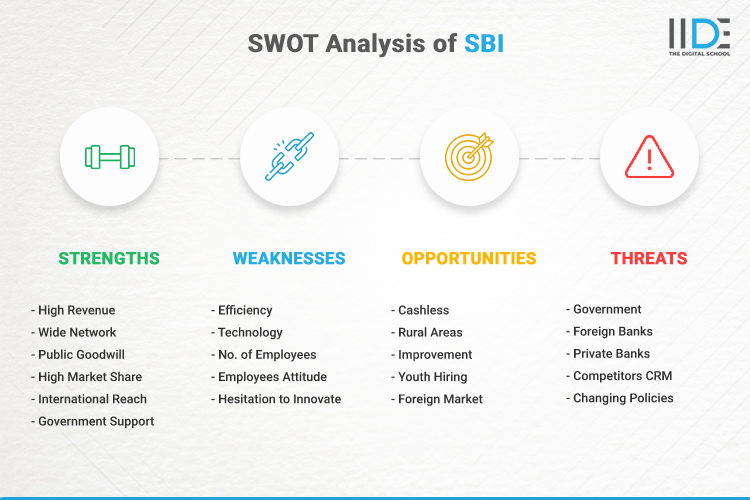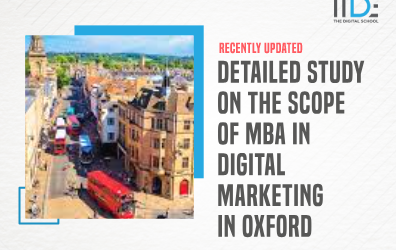The last time we saw the SWOT analysis of Indian Overseas Bank. But this time we will explain the SWOT analysis of SBI elaborately.
SBI is the world’s 55th largest bank ranked at 221st in the Fortune Global 500 list of the world’s biggest corporations of 2020, being the only Indian bank on this list. The rich heritage and legacy of over 200 years, accredits SBI as the most trusted bank by Indians through generations.
The marketing strategy of the SBI includes traditional as well as digital marketing. In today’s time, digital marketing is very important for reaching out to customers as everything is shifting towards digital. If you want to learn digital marketing and its scope, do check out Free Digital Marketing Masterclass by Karan Shah, the founder and CEO of IIDE.
Before we dive into the SWOT Analysis of SBI, let’s take a look at the company, its history, finances, products, and opponents.
About SBI

State SBI (SBI) is an Indian multinational public sector bank that deals in the banking and finance sector. The bank descends from the Bank of Calcutta, founded in 1806 via the Imperial SBI, making it the oldest commercial bank in the Indian Subcontinent.
The Bank of Madras merged with the other two presidency banks in British India, the Bank of Calcutta and the Bank of Bombay, to form the Imperial SBI, which in turn became the State SBI in 1955. Overall the bank has been formed from the merger and acquisition of nearly twenty banks throughout its 200-year history. The Government of India took control of the Imperial SBI in 1955, with the Reserve SBI (India’s central bank) taking a 60% stake, renaming it as state SBI.
The Bank has successfully diversified businesses through its various subsidiaries i.e. SBI General Insurance, SBI Life Insurance, SBI Mutual Fund, SBI Card, etc. It has spread its presence globally and operates across time zones through 229 offices in 31 foreign countries.
SBI, the largest Indian Bank with 1/4th market share, serves over 45 crore customers through its vast network of over 22,000 branches, 62617 ATMs/ADWMs, 71,968 BC outlets, with an undeterred focus on innovation, and customer-centricity, which stems from the core values of the Bank – Service, Transparency, Ethics, Politeness, and Sustainability.
It is a public sector bank and the largest bank in India with a 23% market share by assets and a 25% share of the total loan and deposits market. It is also the fifth-largest employer in India with nearly 250,000 employees. Growing with time, SBI continues to redefine banking in India, as it aims to offer responsible and sustainable Banking solutions.
| Founder | Dinesh Kumar Khara |
|---|---|
| Year Founded | 1955 |
| Origin | Mumbai, India |
| No. of Employees | 245,642 |
| Company Type | Public |
| Market Cap | $63.19 Billion (2021) |
| Annual Revenue | Rs 385,338 Crore (2021) |
| Net Income/ Profit | Rs 22,405 Crore (2021) |
Current news about the brand
- State Bank of India (SBI) a Fortune 500 company, is an Indian Transitional, Public Sector Banking and Financial Services statutory body headquartered in Mumbai. The rich heritage and heritage of over 200 times, accredits SBI as the most trusted Bank by Indians through generations.
- SBI Mutual Fund Gets RBI Nod For Stake Buy In IndusInd Bank.
- Calcutta High Court voids SBI’s sale of Atibir Industries’ loans to CFM ARC.
- Share price of SBI Card jumps as Sensex gains 374.09 points.
- SBI, HDFC to ICICI: RBI enrolls 30 banks on the UDGAM portal for unclaimed deposits.
Buyer Persona

Buyer’s Persona
Name:
Amit
Place:
Chennai
Age:
29 years
Profession:
Businessman
Motivation
- Global Business Expansion
- Diversification of Product Portfolio
- Access to Emerging Markets
- Supply Chain Optimization
- Infrastructure Development Projects
Interest & Hobbies
- Reading.
- Playing Soccer.
- Playing Guitar.
- Surfing Quora.
Pain Points
- Investors and Shareholders
- Small and Medium Enterprises
- Startups and Innovators
- Environmental Organisations
Social Media Presence
- Youtube
- Quora
After understanding the core of the corporation, let us now proceed to the SWOT analysis of SBI.
SWOT Analysis of SBI
A SWOT analysis is a strategic planning method used to evaluate the strengths, weaknesses, opportunities, and threats involved in a project or a business venture. A good SWOT analysis can help you reach your online marketing goals or kick your business startup into high gear.
To better understand the SWOT analysis of SBI, refer to the infographic below:

Let’s proceed further with expanding on the strengths of the SBI from the SWOT analysis of SBI.
Strengths of SBI
- Government Support: Being a public sector bank it has the full support of the Indian government which can be considered as one of the major strengths.
- Public Goodwill: Being a bank with a history of more than 2 centuries it has accumulated a huge amount of goodwill. The belief that the public or the consumer has towards it is at excellence.
- High Revenue: Being a multinational company ranked at 221st position in the Fortune Global 500 it sure does own a huge revenue and capital which is a strength in itself.
- Wide Network: According to recent reports, the bank has more than 22,141 branches and 58,555 ATMs.
- International Reach: SBI is active in 36 countries involved in currency traders around the world.
- High Market Share: SBI is the largest bank in India with a 23% market share by assets and a 25% share of the total loan and deposits market.
Weaknesses of SBI
- Employees Attitude: Due to having a secured government job most of the employees don’t have a good attitude towards the consumers.
- Technology: The lack of adequate technology-driven infrastructure relative to private banks.
- Efficiency: Employees are hesitant to fix issues efficiently due to better job stability.
- Hesitation to Innovate: Despite the modernization, the bank still conveys the perception of the traditional bank to new-age clients.
- No. of Employees: SBI has the largest number of employees in the banking sector, which is why the bank spends a considerable amount of its income on employees’ salaries.
Opportunities for SBI
Opportunities are potential areas of focus for a company to improve results, increase sales, and, ultimately, profit.
- Youth Hiring: Pool in talent to replace top management to serve the next generation and bring about innovation. This will also enable driving the latest innovation into the company.
- Improvement: SBI can make better use of the CRM, new technology, and the online space to increase its banking business.
- Rural Areas: Expansion into the rural areas will also boost its business to a new level.
- Cashless: With a focus on India going cashless, the bank that supports cashless features by evolving its methods and technology can dominate the market with its extensive reach.
- Foreign Market: Expanding its business in the foreign market also holds a huge scope of growth for SBI.
Threats to SBI
- Private Banks: Consolidation among private banks can reduce market share for SBI by a huge margin.
- Changing Policies: Banking policies are governed by Reserve SBI (RBI) laws and regulations, therefore any changes made by the RBI have a direct impact on the bank’s operations.
- Foreign Banks: Foreign banks that have sophisticated products can fully affect the old strategy of SBI.
- Government: SBI operations are often disrupted by slow government decisions and red-tapism.
- Competitors CRM:- Competitors with good CRM systems are a threat to the SBI.
Failed Campaigns of SBI
What was the issue?
Many customers did not fully understand the concept of InTouch branches and the digital services they offered. This resulted in a lack of interest and adoption among the target audience.
What backlash did the brand face?
The campaign’s emphasis on modernity and sophistication gave some customers the impression that SBI was shifting its focus away from serving all segments of the population, including those in rural and less affluent areas
What did the brand do in this situation?
The “SBIInTouch” campaign highlighted the importance of aligning marketing strategies with the needs and preferences of the target audience.
Top 5 Competitors of SBI
- ICICI Bank: It is one of the largest private sector banks in India and offers a wide range of financial products and services.
- HDFC Bank: It is another major private sector bank in India known for its retail and commercial banking services.
- Punjab National Bank (PNB): It is one of the largest public sector banks in India and competes with SBI in various banking services.
- Axis Bank: It is another prominent private-sector bank with a significant presence in the Indian banking sector.
- Bank of Baroda: It is a leading public sector bank and competes with SBI in areas such as retail and corporate banking.
To Conclude
To sum up, SBI has a huge mass of incredibly innovative services providing enough options. The company has the advantage of the brand trust of thousands in India. It has been updated with technology although not the most advanced but not behind as well; however, SBI should start focusing on creative advertisement to attract more inventors in India as well as internationally.
With a huge increase in the service industry. There is a very high competition where marketing plays a crucial role in taking advantage of technology not merely in this industry in which every other company is focusing on digital marketing to rise ahead of each other. If you have the curiosity to learn you may check out IIDE’s 3 Month Advanced Online Digital Marketing Course to know more.
We hope this blog on the SWOT analysis of SBI has given you a good insight into the company’s strengths, weaknesses, opportunities, and threats. If you enjoy in-depth company research just like the SWOT analysis of SBI, check out our IIDE Knowledge portal for more fascinating case studies.
Thank you for investing your valuable time to read this, and do share your thoughts on this case study of the SWOT analysis of SBI in the comments section below.







SBI excels as a market leader with a vast network, poised for growth despite challenges in asset quality and technology.